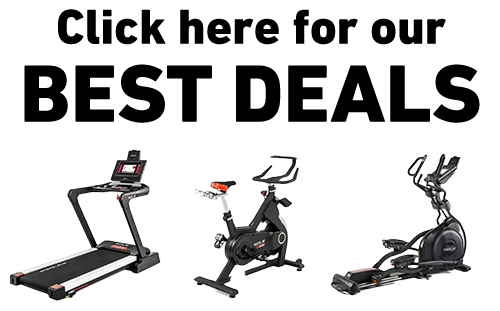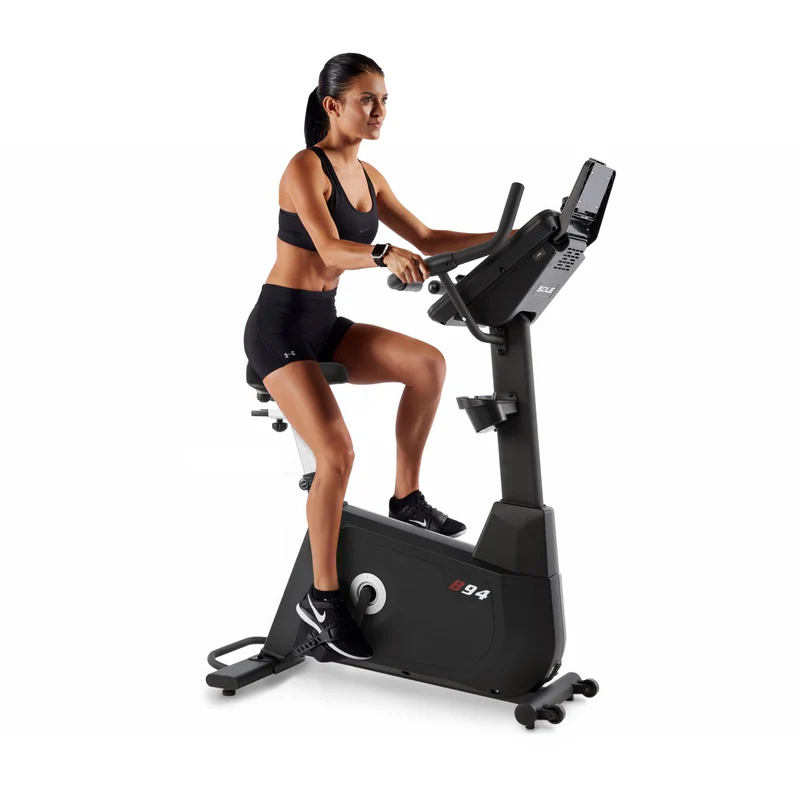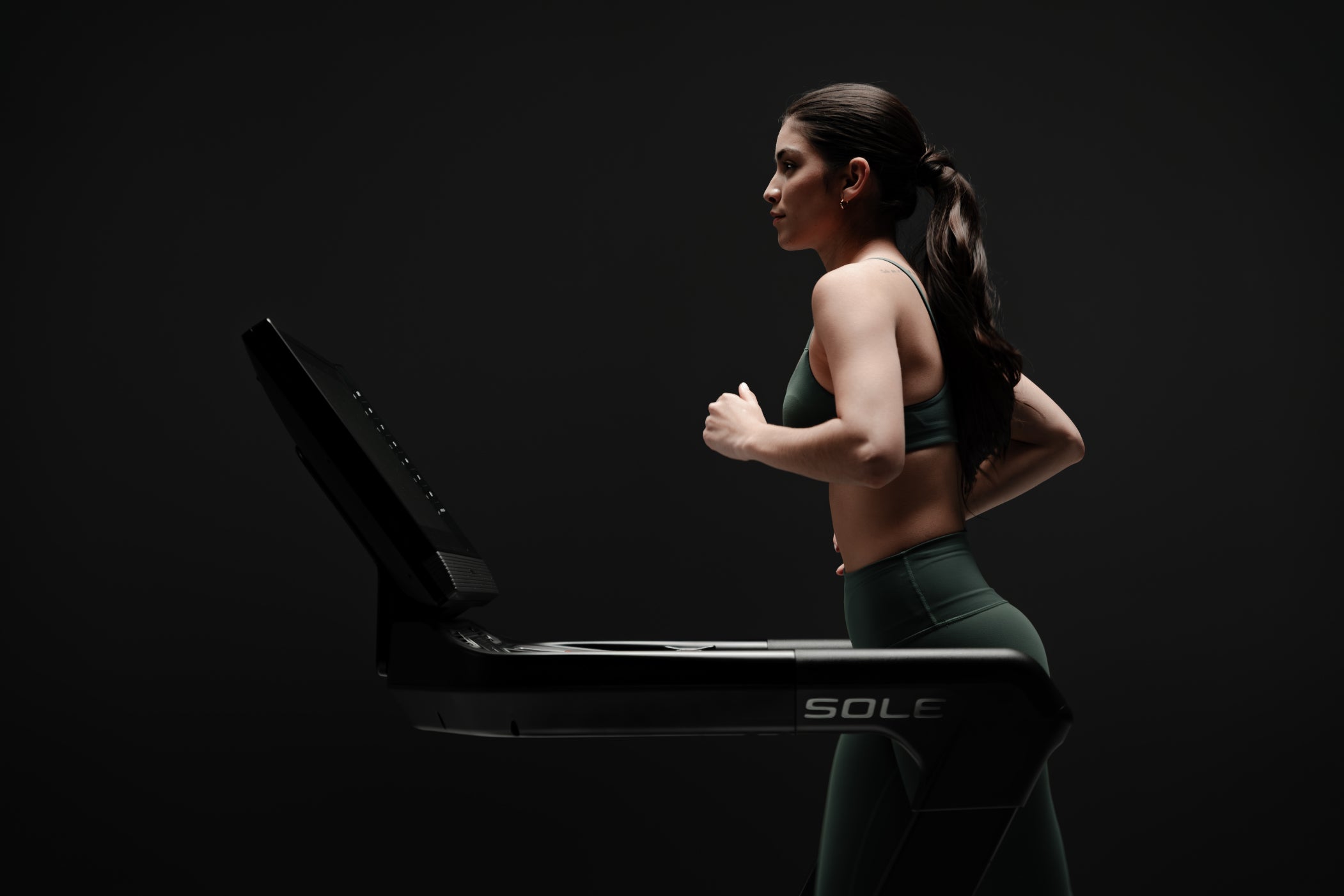Key Takeaways
- Rowing machines offer a full-body workout, engaging multiple muscle groups.
- Exercise bikes are user-friendly and target mainly the muscles in the lower part of the body.
- Rowing machines can burn around 600-800 calories per hour, while exercise bikes can burn about 400-600 calories per hour.
- Both machines provide low-impact exercise, but rowing machines might be better for joint health.
|
At SOLE Fitness, we're proud to offer the best treadmills for your home or gym. These machines are crafted to meet the highest standards of quality and performance, ensuring they are ideal for anyone - from fitness novices to seasoned athletes. Featured Product
|
Rowing Machine vs Bike: Quick Comparison
Both rowing machines and exercise bikes are excellent for cardiovascular health and can help you shed those extra pounds. However, they work your body in different ways and offer distinct experiences.
|
Feature |
Rowing Machine |
Exercise Bike |
|
Workout Type |
Full-body workout engaging both upper and lower body |
Primarily lower-body workout focusing on legs |
|
Muscle Engagement |
Engages 85% of muscle groups (arms, back, core, legs) |
Primarily targets quadriceps, hamstrings, calves, and glutes |
|
Caloric Burn |
Higher calorie burn (600-800 calories) at vigorous intensities; effective for HIIT |
Comparable calorie burn (400-600 calories), but often requires longer sessions for similar results |
|
Impact on Joints |
Low-impact, but requires proper technique to avoid strain |
Low-impact, generally easier on joints, suitable for those with joint issues |
|
Comfort |
Requires good technique; may be uncomfortable for beginners |
Generally comfortable with a seated position; easier for beginners |
|
Space Requirements |
Typically requires more space; some models are foldable |
Generally more compact and easier to store; various sizes available |
|
Workout Variety |
Offers full-body workouts; less variety in terrain simulation |
More variety in workouts, including virtual classes and terrain simulation |
|
User Experience |
May take time to learn proper form; rewarding once mastered |
Easier to use; more accessible for casual users |
|
Best For |
Those seeking a comprehensive workout and willing to learn proper technique |
Beginners or those focusing on lower-body strength and comfort |
Why Choose Based on Personal Goals
Your choice between a rowing machine and an exercise bike should align with your fitness objectives. If you're looking for a full-body workout, a rowing machine might be the way to go; but if you prefer focusing on lower body strength and enjoy a more straightforward workout, an exercise bike could be your best bet.
Considerations to Make Your Decision Easier
You also need to consider factors like available space, budget, and any joint concerns. Both machines are low-impact, but they differ in their approach to working your muscles and burning calories.
Rowing Machine Benefits
Full-Body Workout
Rowing machines provide a comprehensive workout that engages your entire body - from your arms and shoulders to your core and legs, rowing activates a wide range of muscle groups, helping you build overall strength and endurance.
Our SOLE rower also has an air and magnetic resistance motion that helps create a “on the water” sensation - this makes workouts enjoyable too.
Muscle Groups Engaged
When you row, you use around 85% of your muscles - this includes your quadriceps, hamstrings, glutes, back, shoulders, and arms. The continuous, repetitive motion helps tone and strengthen these muscles, contributing to a more balanced physique.
Calorie Burn
Rowing is a highly effective way to burn calories: on average, you can expect to burn between 600 to 800 calories per hour, depending on your intensity and weight. As such, rowing is an excellent choice for those looking to lose weight quickly and efficiently.
Low-Impact Exercise
One of the standout benefits of rowing is its low-impact nature. Unlike running or jumping, rowing is gentle on your joints, and is suitable for people of all fitness levels, including those with joint issues or recovering from injuries.
![]()
Exercise Bike Benefits
Many people incorporate exercise bikes in their workout regimens because of their simplicity and effectiveness, as well as their ability to provide a great cardiovascular workout and ease of use. Whether you're a beginner or an experienced athlete, an exercise bike can be a valuable addition to your fitness regimen.
Lower Body Focus
Exercise bikes primarily target the lower body - when you pedal, you're working your quadriceps, hamstrings, calves, and glutes, building strength and endurance in your legs.

Ease of Use
One of the biggest advantages of exercise bikes is their user-friendly nature. Unlike some fitness equipment that requires a learning curve, exercise bikes are straightforward and easy to use - simply hop on, adjust the seat and resistance, and start pedaling.
For example, our upright exercise bike model – the SOLE LCB – has a flywheel weight of 27 lbs and resistance range of 40 levels. It also comes with 10 pre-programmed and 12 user defined workout routines for beginners to start immediately.
Calorie Burn
Exercise bikes are quite effective for burning calories - depending on your intensity and weight, you can burn between 400 to 600 calories per hour. While this might be slightly lower than what you can achieve with a rowing machine, it's still a significant amount and can help you achieve your weight loss goals.
Comfort and Accessibility
Besides being easy to use, exercise bikes are also very comfortable: most models come with adjustable seats and handlebars, allowing you to find the perfect fit. Additionally, they are accessible to people of all fitness levels and can be used in the comfort of your home, making it easier to stay consistent with your workouts.
In fact, we also offer recumbent exercise bikes such as the LCR and R92 that come with large, plush seats to reduce tailbone pain while exercising.

Detailed Comparison
Cardiovascular Benefits
Both rowing machines and exercise bikes offer excellent cardiovascular benefits - they help improve heart health, increase lung capacity, and boost overall endurance. However, the way they achieve these benefits differs: rowing machines provide a more intense, full-body cardio workout, while exercise bikes offer a steady, lower-body-focused cardio session.
Calorie Burn Comparison
Rowing machines have a slight edge for calorie burn. You can burn between 600 to 800 calories per hour on a rowing machine, compared to 400 to 600 calories on an exercise bike. This difference can be attributed to the full-body engagement that rowing offers, which demands more energy and, therefore, burns more calories.
Muscle Engagement
Rowing machines engage multiple muscle groups, including your legs, core, back, and arms, or about 86% of the body's muscles, helping build overall strength and endurance. In contrast, exercise bikes primarily target the lower body muscles, such as the quadriceps, hamstrings, calves, and glutes. While both machines are effective, rowing has a more balanced muscle workout.
Impact on Joints
Both rowing machines and exercise bikes are low-impact, making them suitable for people with joint issues or those recovering from injuries. However, rowing machines might have an edge in this department because they distribute the effort across multiple muscle groups, reducing the strain on any single joint. Exercise bikes, while still low-impact, concentrate the effort on the lower body, which might not be ideal for those with knee or hip issues.
Factors to Consider
Fitness Goals
Your fitness goals should be the primary factor in your decision. If you're looking for a full-body workout that builds overall strength and endurance, a rowing machine might be the better choice. On the other hand, if your focus is on lower body strength and you prefer a more straightforward workout, an exercise bike could be the way to go.
Injury or Joint Concerns
If you have any existing injuries or joint concerns, it's essential to choose equipment that won't exacerbate these issues. Both rowing machines and exercise bikes are low-impact, but rowing machines distribute the effort more evenly across your body, potentially making them a better option for joint health.
Space and Budget Constraints
Space and budget are practical considerations that can significantly influence your decision. Rowing machines, like the SOLE SR550, can take up more space compared to exercise bikes. Fortunately, our rowing machine can be folded with wheels at the front for easy storage and moving.

Enjoyment and Consistency
Ultimately, the best exercise equipment is the one you enjoy using - some people love the rhythmic motion of rowing, while others prefer the simplicity of cycling. Consistency is key to achieving your fitness goals, so choose the machine that you find more enjoyable and are more likely to use regularly.
Final Thoughts
Rowing machines offer a full-body workout, engaging multiple muscle groups, while bikes primarily focus on the lower body. Rowing can help improve posture and strengthen the back, which is beneficial for those with sedentary lifestyles. On the other hand, cycling is a low-impact exercise that is easier on the joints, making it suitable for individuals with joint issues or injuries.
At SOLE, we provide both a rowing machine and exercise bikes - your choice should align with your personal fitness goals, preferences, and any physical limitations. Our collections of exercise machines are durable and come with a solid warranty to give you a peace of mind when you’re exercising.
Frequently Asked Questions (FAQ)
Which burns more calories?
Rowing machines generally burn more calories compared to exercise bikes - you can expect to burn between 600 to 800 calories per hour on a rowing machine, while exercise bikes typically burn between 400 to 600 calories per hour.
Is the rowing machine harder to use?
Rowing machines can be more challenging to use initially because they require coordination and proper technique to engage multiple muscle groups effectively. However, with practice, most people can master the rowing motion and enjoy its benefits.
Which is better for joint health?
Both rowing machines and exercise bikes are low-impact and gentle on the joints. However, rowing machines might have a slight edge because they distribute the effort across multiple muscle groups, reducing the strain on any single joint.



Leave a comment
This site is protected by hCaptcha and the hCaptcha Privacy Policy and Terms of Service apply.